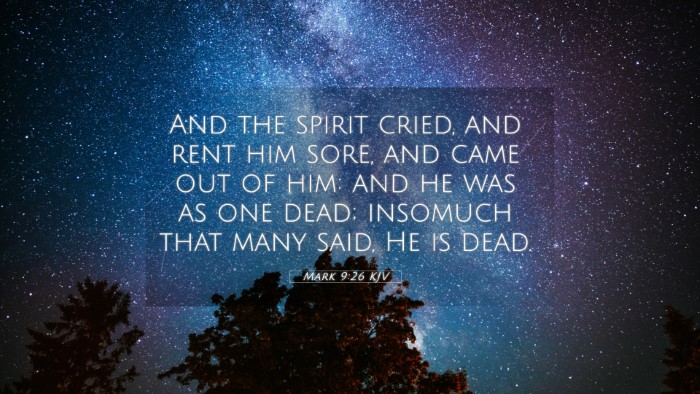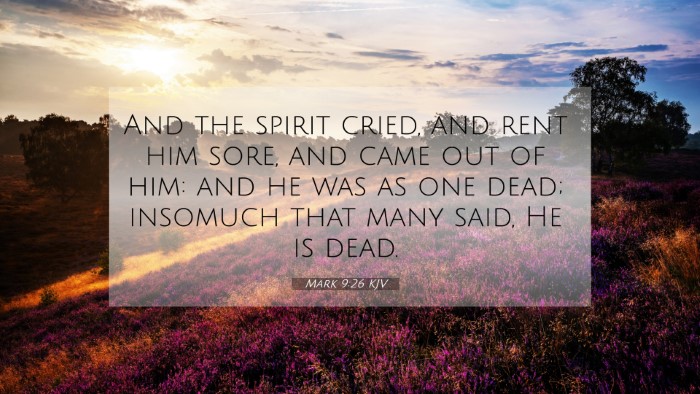Understanding Mark 9:26
Verse Reference: Mark 9:26 - "And the spirit cried out, and convulsed him much, and came out of him: and he was as one dead; insomuch that many said, He is dead."
Summary of Meaning
Mark 9:26 recounts the dramatic moment when Jesus casts out a spirit from a boy who was possessed. The verse illustrates the power of Jesus over demonic forces, emphasizing His authority and ability to perform miracles. This event is part of a larger narrative where Jesus confronts disbelief and demonstrates His divinity through supernatural acts.
Commentary Insights
-
Matthew Henry:
Henry highlights the miraculous nature of the healing and the intensity of the struggle between the boy and the evil spirit. The boy's violent convulsions signify the strength of the demonic presence, and that the people thought he was dead signifies the seriousness of the condition he was in before Jesus intervened.
-
Albert Barnes:
Barnes notes the reactions of the bystanders. Many believed that the boy was beyond help, appearing lifeless after the spirit was driven out. This demonstrates the disbelief that surrounded Jesus's ministry and the skepticism regarding His power to perform miracles.
-
Adam Clarke:
Clarke points out that the term 'dead' signifies not a physiological state but the extreme condition the boy was in after the spirit's departure. This emphasizes the transformative power that Jesus has—not only in freeing individuals from demonic influence but also in restoring life and health.
Connections to Other Bible Verses
The verse connects with several other passages in the Bible that tackle themes of healing, deliverance, and the display of divine authority. Below are key cross-references that offer deeper understanding:
- Matthew 17:18: "And Jesus rebuked the devil; and he departed out of him: and the child was cured from that very hour." - This verse relates to healing and demonstrates Jesus' authority over demonic forces.
- Mark 1:27: "And they were all amazed, insomuch that they questioned among themselves, saying, What thing is this? What new doctrine is this? for with authority commandeth he even the unclean spirits, and they do obey him." - Here, the authority of Jesus is highlighted.
- Luke 8:29: "For he had commanded the unclean spirit to come out of the man." - This passage reiterates Jesus' direct command over unclean spirits.
- John 10:10: "The thief cometh not, but for to steal, and to kill, and to destroy: I am come that they might have life, and that they might have it more abundantly." - The purpose of Jesus' coming is to restore life and health.
- Acts 10:38: "How God anointed Jesus of Nazareth with the Holy Ghost and with power: who went about doing good, and healing all that were oppressed of the devil; for God was with him." - This signifies the ministry of healing and deliverance that Jesus enacted.
- Matthew 9:32-33: "As they went out, behold, they brought to him a dumb man possessed with a devil. And when the devil was cast out, the dumb spake..." - This similar miracle further emphasizes the theme of Jesus' deliverance of those afflicted by evil spirits.
- Mark 5:8: "For he said unto him, Come out of the man, thou unclean spirit." - Another instance where Jesus commands an unclean spirit to depart strengthens the connection across the Gospels.
Thematic Connections
Mark 9:26 can be placed within the broader themes of:
- Authority of Christ: The power that Jesus wields over spiritual and physical ailments.
- Faith and Doubt: The contrast between the faith of the father of the possessed boy (who brought him to Jesus) and the doubt seen among the onlookers.
- Healing and Restoration: The transformative effect of encountering Jesus, leading not just to recovery from affliction but to a complete restoration of life.
Tools for Bible Cross-Referencing
Understanding the intricate web of biblical connections can enhance one's study. Here are some tools and methods for effective cross-referencing:
- Bible Concordance: A comprehensive index of scripture that helps in locating specific words and themes within the text.
- Bible Cross-Reference Guide: Resources that lay out links between verses based on themes, concepts, or characters.
- Cross-Reference Bible Study: A method that involves exploring related verses to gain a fuller understanding of a passage.
- Inter-Biblical Dialogue: Engaging with various texts to see how different authors and books address similar themes or events.
- Bible Reference Resources: Various commentaries, study Bibles, and biblical encyclopedias that provide insights and explanations of connections.
- Comprehensive Biblical Cross-Reference Materials: Collections of scripts showcasing multiple correlations for thematic studies.
- Cross-Referencing Psalms with New Testament Teachings: This method offers profound insight into the continuity of biblical themes across the Testaments.
The Importance of Connecting Scriptures
Engaging in a comparative Bible verse analysis not only heightens understanding of a specific passage like Mark 9:26 but also reveals the rich tapestry of God's word. Each verse offers a unique perspective while contributing to a unified message of salvation, healing, and divine authority.
Conclusion
Mark 9:26 serves as a powerful reminder of Jesus' authority over darkness and His commitment to bringing life from death. By reflecting on this verse and exploring its connections to other scriptures, believers can deepen their understanding of the Gospel message and the nature of Christ's miraculous works.







